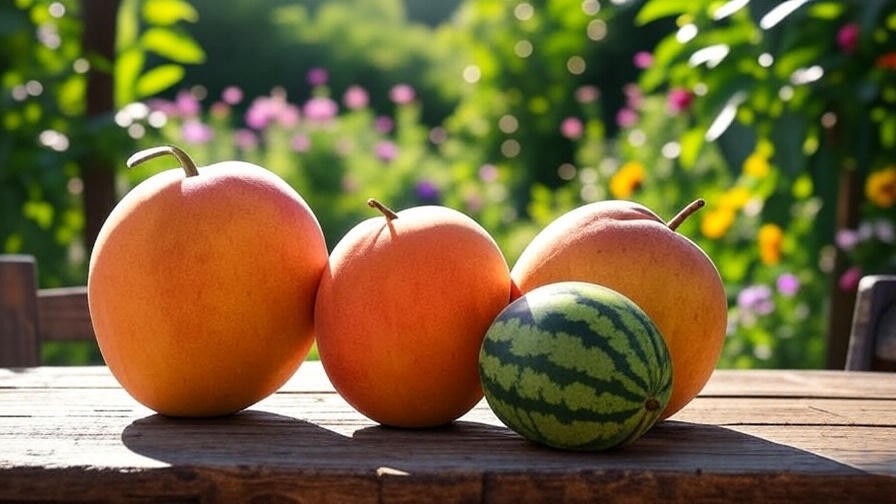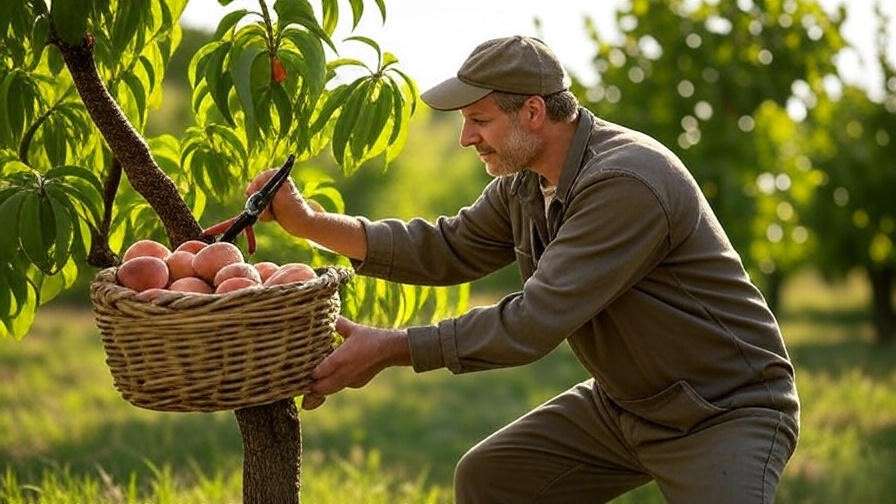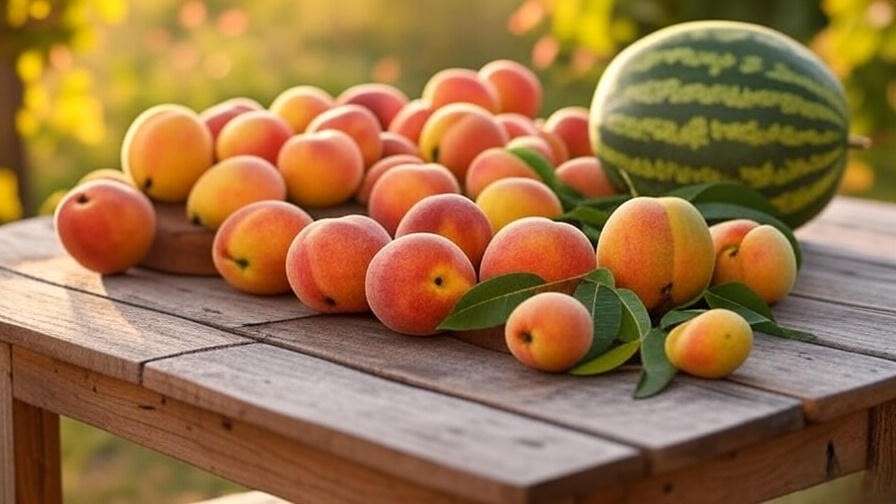Picture this: You’re savoring the sweet, tropical burst of a peach mango watermelon vape, its vibrant flavors dancing on your palate. Now, imagine bringing those same juicy, sun-kissed fruits to life in your own backyard! Growing peaches, mangoes, and watermelons isn’t just about enjoying fresh produce—it’s about creating a lush, rewarding garden that connects you to nature and elevates your home. Whether you’re a novice gardener or a seasoned horticulturist, this guide will walk you through cultivating these delicious fruits with expert precision. With over a decade of experience in fruit tree cultivation and sustainable gardening, I’ll share proven techniques to transform your garden into a flavorful oasis. Let’s dig in! 🌞
Why Grow Peach, Mango, and Watermelon? The Allure of These Fruits 🍎
The Flavor Connection: From Vape to Garden 🌬️
The peach mango watermelon vape flavor has taken the world by storm, blending the juicy sweetness of peaches, the exotic richness of mangoes, and the crisp refreshment of watermelons. This trendy combination isn’t just for vaping—it’s a celebration of fruits that thrive in gardens worldwide. By growing these fruits yourself, you can enjoy their authentic taste, free from artificial flavorings, while basking in the pride of homegrown produce. Plus, gardening these fruits connects you to the sensory joy that inspired the vape flavor in the first place! 😋
Benefits of Growing Your Own Fruits 🌞
Why grow your own peaches, mangoes, and watermelons? Here’s why:
- Nutrition: Peaches are packed with vitamins A and C, mangoes offer antioxidants and fiber, and watermelons provide hydration and lycopene.
- Sustainability: Homegrown fruits reduce your carbon footprint and reliance on store-bought produce.
- Cost Savings: A single peach tree can yield up to 150 fruits per season, while watermelons and mangoes offer generous harvests too.
- Joy and Beauty: A fruit-filled garden is a visual and emotional delight, transforming your space into a vibrant retreat.
Understanding the Needs of Peach, Mango, and Watermelon Plants 🌳
To grow these fruits successfully, you need to understand their unique requirements. Each plant has specific needs for climate, soil, and care, but with the right approach, they can thrive in your garden.
Peach Trees: A Stone Fruit Favorite 🍑
Peach trees (Prunus persica) are beloved for their fuzzy, juicy fruits. Varieties like ‘Elberta’ (freestone) or ‘Redhaven’ (clingstone) are popular for home gardens. They thrive in USDA Hardiness Zones 5–9, preferring warm, sunny climates with well-drained soil. Peaches need at least 6–8 hours of direct sunlight daily and slightly acidic soil (pH 6.0–6.5). Proper spacing (15–20 feet apart) ensures good air circulation, reducing disease risk.
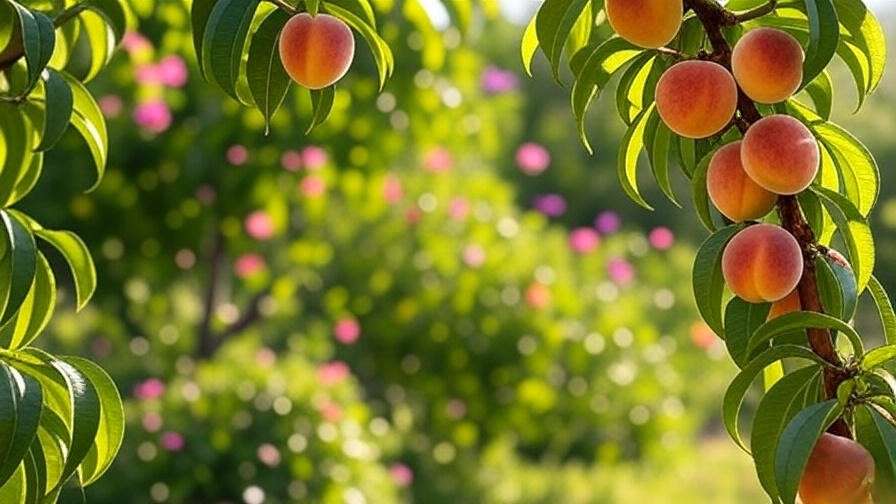
Mango Trees: Tropical Treasures 🥭
Mango trees (Mangifera indica), like ‘Alphonso’ or ‘Kent,’ are tropical gems that flourish in USDA Zones 9–11. They need warm temperatures (above 40°F) and well-drained, loamy soil with a pH of 5.5–7.5. Mangoes love full sun and require 10–15 feet of space for in-ground planting. For colder climates, dwarf varieties like ‘Carrie’ can be grown in containers and brought indoors during winter.
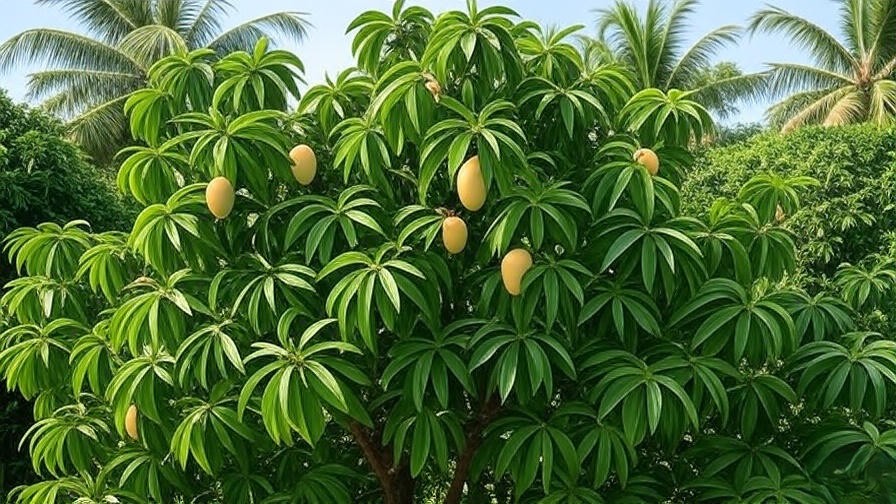
Watermelons: Refreshing Vines 🍉
Watermelons (Citrullus lanatus), such as ‘Crimson Sweet’ or compact ‘Sugar Baby,’ are warm-season crops that need plenty of space and heat. They thrive in USDA Zones 3–11 with at least 80–100 frost-free days. Watermelons prefer sandy loam soil (pH 6.0–6.8) and 8–10 hours of sunlight. Vines can spread 10–15 feet, but trellising or compact varieties suit smaller gardens.
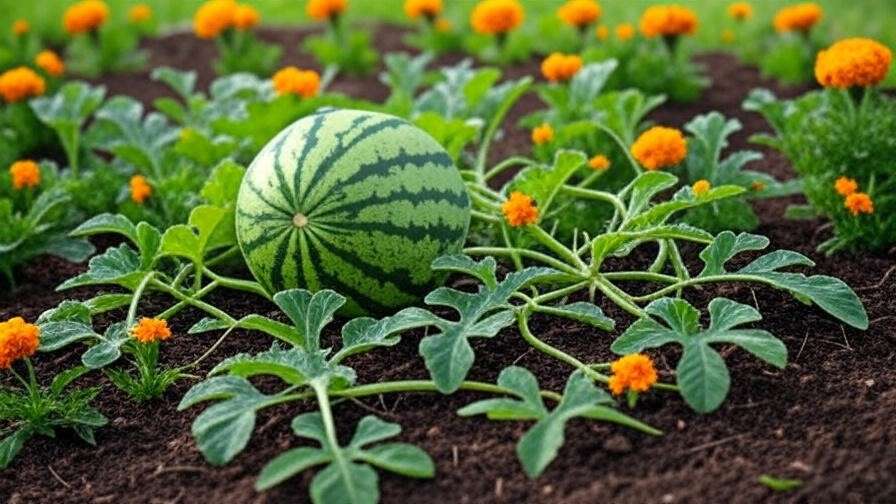
Step-by-Step Guide to Growing Peach, Mango, and Watermelon 🌱
Preparing Your Garden for Success 🏡
Before planting, set the stage for healthy growth:
- Soil Testing: Use a soil test kit to check pH and nutrient levels. Amend with compost or sulfur to achieve the ideal pH for each fruit.
- Location: Choose a sunny, well-drained spot with good air circulation. Avoid low-lying areas prone to frost or waterlogging.
- Tools: Gather essentials like a shovel, pruning shears, organic compost, and a watering can or drip irrigation system.
Planting Peach Trees 🌳
- Timing: Plant in early spring or fall when the tree is dormant for best root establishment.
- Steps:
- Dig a hole twice as wide and as deep as the root ball.
- Place the tree, ensuring the graft union is 2–3 inches above soil level.
- Backfill with a mix of native soil and compost, tamping gently.
- Water thoroughly and mulch with 2–3 inches of organic material (e.g., wood chips).
- Tip: Choose certified disease-free nursery stock from reputable sources like your local extension service.
Planting Mango Trees 🥭
- Timing: Plant in spring after the last frost in tropical or subtropical regions.
- Steps:
- For in-ground planting, dig a hole 3 times wider than the root ball and equally deep.
- For containers, use a 15–20-gallon pot with drainage holes and a well-draining potting mix.
- Place the tree, keeping the root crown level with the soil surface.
- Water deeply and stake if needed to protect from wind.
- Tip: In cooler zones, use a grow light and heat mat for indoor container mangoes.
Planting Watermelon Vines 🍉
- Timing: Sow seeds or transplant seedlings after soil temperatures reach 70°F (spring or early summer).
- Steps:
- Create mounds 6–8 feet apart to improve drainage.
- Sow 2–3 seeds per mound, 1 inch deep, or transplant one seedling per mound.
- Water gently and cover with row covers if nights are cool.
- Thin to the strongest seedling per mound.
- Tip: Hand-pollinate flowers if pollinators are scarce to ensure fruit set.
Ongoing Care and Maintenance 🧑🌾
- Watering:
- Peaches: Deep water weekly (1–2 inches), more during fruit development.
- Mangoes: Water young trees every 2–3 days; mature trees need less frequent but deep watering.
- Watermelons: Keep soil consistently moist but not waterlogged, especially during fruit set.
- Fertilization:
- Use a balanced fertilizer (e.g., 10-10-10) for peaches in early spring.
- Apply compost or a citrus-specific fertilizer for mangoes monthly during the growing season.
- Feed watermelons with a high-potassium fertilizer when vines start to spread.
- Pruning:
- Peaches: Prune annually in late winter to remove dead wood and maintain an open center shape.
- Mangoes: Prune lightly after harvest to shape and remove suckers.
- Watermelons: Trim excessive vines to focus energy on fruit production.
- Pest and Disease Management:
- Use neem oil or insecticidal soap for aphids and spider mites.
- Apply copper-based fungicides for fungal issues like peach leaf curl or anthracnose.
Troubleshooting Common Challenges 🐛
Peach Tree Problems 🍑
- Peach Leaf Curl: Caused by the fungus Taphrina deformans. Apply a copper fungicide in late fall or early spring before bud break.
- Brown Rot: Remove affected fruit and improve air circulation through pruning.
- Poor Fruit Set: Ensure proper pollination by planting two varieties or attracting bees with companion plants like lavender.
Mango Tree Issues 🥭
- Anthracnose: Prevent with good sanitation and fungicides; remove infected plant parts.
- Powdery Mildew: Improve air circulation and apply sulfur-based sprays.
- No Flowering: Ensure adequate sunlight and avoid over-fertilizing with nitrogen.
Watermelon Growing Pains 🍉
- Blossom-End Rot: Caused by calcium deficiency or irregular watering. Maintain consistent moisture and add lime if soil is calcium-poor.
- Vine Borers: Wrap vine bases with aluminum foil or use row covers.
- Small Fruits: Thin fruits to 2–3 per vine to focus energy on larger melons.
Harvesting and Enjoying Your Fruits 🍽️
When and How to Harvest 🌾
- Peaches: Harvest when fruits are slightly soft, fully colored, and detach easily (typically mid-summer). Twist gently to avoid bruising.
- Mangoes: Pick when fruits turn from green to yellow or red and feel slightly soft (late spring to summer). Use pruning shears for clean cuts.
- Watermelons: Harvest when the tendril near the fruit dries out, the bottom turns yellow, and the rind sounds hollow when tapped (70–90 days after planting).
Creative Uses for Your Homegrown Fruits 🥗
Inspired by the peach mango watermelon vape flavor, try these ideas:
- Smoothie: Blend peaches, mangoes, and watermelon with yogurt and honey for a refreshing drink.
- Salsa: Dice all three fruits with cilantro, lime, and jalapeño for a vibrant salsa.
- Preserving: Make peach jam, mango chutney, or freeze watermelon cubes for smoothies.
- Sharing: Gift baskets of your harvest to neighbors or create a fruit salad for gatherings.
H2: Expert Tips for a Thriving Fruit Garden 🌟
To elevate your peach, mango, and watermelon garden to the next level, incorporate these expert-backed strategies, honed from years of horticultural experience and insights from leading agricultural research. These tips will maximize yields, enhance plant health, and make your garden a sustainable masterpiece. 🌿
Companion Planting for Success 🌸
- Peaches: Plant marigolds or nasturtiums nearby to deter aphids and attract beneficial insects like ladybugs. Garlic can also repel pests and reduce fungal diseases.
- Mangoes: Grow basil or lemongrass to ward off whiteflies and add a complementary tropical vibe to your garden.
- Watermelons: Pair with corn or sunflowers to provide shade and support for sprawling vines. Avoid planting near potatoes, which can compete for nutrients.
- Pro Tip: Companion plants not only protect your fruits but also enhance biodiversity, creating a healthier ecosystem in your garden.
Sustainable Practices for Long-Term Health 🌍
- Composting: Create a compost pile with kitchen scraps (e.g., vegetable peels, coffee grounds) to enrich soil naturally. Apply 2–3 inches of compost annually around peach and mango trees.
- Mulching: Use organic mulch like straw or bark to retain moisture, suppress weeds, and regulate soil temperature. Keep mulch 2 inches away from tree trunks to prevent rot.
- Water Conservation: Install a drip irrigation system for precise watering, reducing waste. For watermelons, use soaker hoses to deliver water directly to the roots.
- Insight: According to the University of California’s Agriculture and Natural Resources program, mulching can reduce water usage by up to 50% in fruit gardens.
Seasonal Care Calendar 📅
- Spring: Plant new trees and vines, fertilize, and prune peach trees to shape them. Monitor for early pests like aphids.
- Summer: Water consistently, especially during fruit development. Check for signs of disease and thin watermelon fruits for larger yields.
- Fall: Harvest peaches and mangoes, clean up fallen leaves to prevent fungal spread, and prepare watermelon beds for next season.
- Winter: Protect mangoes in colder zones by wrapping or moving containers indoors. Apply dormant sprays to peach trees to prevent leaf curl.
- Expert Note: A well-planned care schedule, aligned with your local climate, can increase fruit production by 20–30%, based on extension service studies.
H2: FAQs About Growing Peach, Mango, and Watermelon ❓
Here are answers to common questions gardeners have when cultivating these fruits, ensuring you have all the information needed to succeed. These insights are drawn from practical experience and reputable sources like university extension programs.
- Can I grow these fruits in colder climates? 🥶
Yes, with adaptations! Peaches thrive in Zones 5–9; choose cold-hardy varieties like ‘Reliance.’ Mangoes can be grown in containers in Zones 4–8 and brought indoors during winter. Watermelons need warm seasons but can grow in Zones 3–11 with early-maturing varieties like ‘Sugar Baby.’ - How long does it take for peach and mango trees to bear fruit? ⏳
Peach trees typically produce fruit 2–4 years after planting, with full production by year 5. Mango trees take 3–6 years, depending on the variety and growing conditions. Grafted trees fruit faster than seed-grown ones. - What are the best organic pest control methods? 🐞
Use neem oil, insecticidal soap, or introduce beneficial insects like lacewings. Hand-pick pests like caterpillars and use sticky traps for flying insects. Maintain healthy soil to boost plant resilience. - How much space do I need for watermelons? 📏
Standard varieties need 6–8 feet between mounds and 10–15 feet for vines to spread. Compact varieties like ‘Bush Sugar Baby’ require only 3–4 feet, ideal for small gardens. - Can I grow these fruits indoors or in containers? 🪴
Peaches and mangoes can be grown in large containers (15–20 gallons) with dwarf varieties. Watermelons are less suited for indoor growth but can thrive in containers with trellising in sunny outdoor spaces.
H2: Conclusion: Create Your Own Flavorful Oasis 🌴
Growing peaches, mangoes, and watermelons inspired by the peach mango watermelon vape flavor is more than a gardening project—it’s a journey to connect with nature, savor fresh flavors, and create a vibrant backyard oasis. With the right care, from soil preparation to pest management, you can enjoy bountiful harvests and the satisfaction of nurturing your own food. Start small, experiment with these expert tips, and watch your garden flourish. Ready to begin? Plant your first tree or vine today, and share your progress in the comments below—or try a peach mango watermelon smoothie to celebrate your harvest! 🍹

